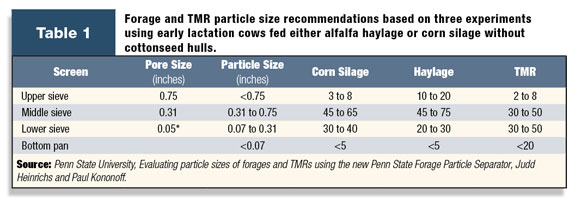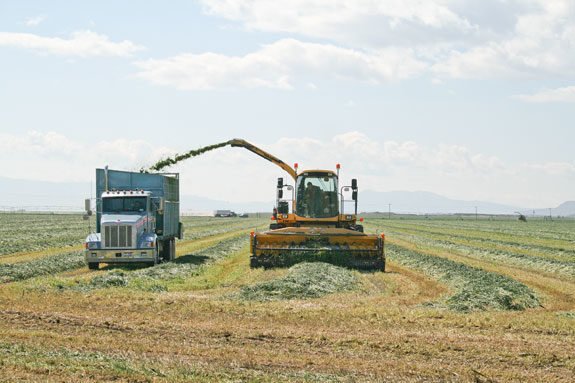The length of chop has an effect on packing in various storage types, which affects the fermentation. Also, there is the effect on fiber.
A short chop minimizes air infiltration into the silo, while a longer chop length increases effective fiber in the diet.
Current recommendations are to harvest grass and alfalfa at a theoretical length-of-cut (TLC) of 3/8- to 1/2-inch and corn at a TLC of 1/2- to 3/4-inch.
Remember that corn harvested for silage at greater than 30 percent dry matter (DM) should be processed to maximize utilization by the animal.
By understanding these elements, you can make decisions for your forage harvest that will provide you with a higher-quality end product to feed your herd.
A coarser or longer cut will not pack as well as a finer chop, allowing more air spaces in between forage particles in the storage facility.
A finer chop will lend to better packing, regardless of the storage structure or moisture. For example, we often see poorer packing in upright silos when producers switch from nonprocessed corn silage (3/8-inch TLC) to processed silage (3/4-inch TLC). In bags, packing can easily be adjusted by cable tension, etc.
In bunker silos, more packing power can be added. But in upright silos, we are still at the mercy of gravity. A shorter cut will help in any of these cases where lower moisture is an issue.
Length of cut, packing and the amount of air present in the storage structure can all affect fermentation. In a proper fermentation, the sugars are mainly used as fuels for the lactic acid bacteria.
In the case of drier feed, poorly packed feed or any other situation that would increase the oxygen present in the storage structure, more of these sugars will be used by the aerobic bacteria, molds and yeasts.
Once the oxygen present decreases and the pH reaches a level that lactic acid bacteria can be viable, the remaining sugars can be used by the lactic acid-producing bacteria present in the feed.
Reducing the time it takes for the pH to drop and oxygen to be eliminated will increase the sugars available for lactic acid production.
We have worked with many producers that prefer a drier haylage but still want longer length of chop.
Using proper packing techniques can reduce the oxygen to be eliminated from the mass and provide a pH drop. This leaves more of the sugars in the forages available for lactic acid fermentation.
How does length of cut affect effective fiber? A longer cut will provide more physical fiber than a shorter cut. In all cases, a shorter cut will reduce the effectiveness of the fiber.
There is a possibility with each storage system to further reduce the chop length prior to feeding, reducing the effective fiber to the cow. In silos, the length can be reduced by the unloader (this is of even more concern with frozen forages).
In bags, the bagger itself can reduce the particle length as the crop is fed through the bagging machine. Bunkers probably have the least chance if a facer is not used.
A facer would slightly reduce the length, but this loss in length is insignificant compared to dry matter losses that would result from a poorly managed face where no facer is used.

Guidelines for particle size
Achieving adequate ration particle size requires using recommended guidelines for forages and TMRs (Table 1).
Original particle size guidelines were based on field data consisting of a large number of farms. Since that time, three intensive research studies have been conducted at Penn State to further refine these guidelines.
The results of forage and TMR particle size distribution can be used in formulating rations and troubleshooting nutrition problems.
Measuring the particle length of individual forages is only one part of the solution. In fact, measuring single forages for particle size is similar to analyzing that forage for crude protein.
There are recommended ranges for individual forages, but the real value of the particle size measurement is in combining forages to achieve the proper TMR particle size, much like combining feeds to achieve the proper protein level in the ration.
The main goal of analyzing TMR particle size is measuring the distribution of feed and forage particles the cow actually consumes.
Examine not only the particles greater than a particular size, but also the overall distribution of feed particles being consumed by the cow.
Measuring TMR samples fresh from the feedbunk and before cows eat or sort the feed is recommended. Mixing and distribution equipment can reduce particle size of feeds and forages and need to be accounted for when evaluating the actual diet being fed.
Corn silage
Corn silage can be quite variable, and the required particle size depends largely on the amount fed in the diet.
If corn silage is the sole forage, at least 8 percent of the particles should be in the upper sieve of the separator, compared to a minimum of 3 percent when corn silage is not the sole forage.
The chop length of corn silage must balance good packing and fermentation with extremely short, pulverized forage.
This means 45 to 65 percent of the silage material should remain on the middle sieve and 30 to 40 percent on the lower sieve of the separator.
If the last screen is used for corn silage, no more than 5 percent should be recovered in the bottom pan.
As corn silage makes up a greater proportion of the ration, more material should remain in the middle two sieves and less in the top sieve and bottom pan.
Newer systems for harvesting corn silage (chopping and rolling in one process) can create silage with a large percentage of long forage particles without large pieces of whole cobs or stalks.
This forage can be excellent quality because it packs and ferments well in the silo. Typically, when conventional choppers are set to harvest corn silage at a long particle size, forage is predisposed to poor silo compaction and mold formation.
The material usually has large pieces of cob, dry stalks and leaves that allow a great deal of sorting and may often be refused by high-producing cows.
Haylage
There is a lot of variability with haylage due to the type and use of machinery, swath type and density, and most of all, the dry matter of the crop harvested.
Ten to 20 percent of the crop should be in the upper sieve of the particle separator. Particle size recommendations may need to be altered based on silo type.
Forages stored in upright, sealed silos would likely fall at the lower end of the range (10 percent). Bunker silos can handle appreciably longer material, up to 20 percent on the upper sieve.
The middle sieve should contain 45 to 75 percent of the material and the lower sieve, 20 to 30 percent. As with corn silage, no more than 5 percent of the material should be retained on the bottom pan.
TMR
Field investigations conducted at Penn State have found considerable variability in overall rations. Feeding management plays an important role in the particle length needs of the cow.
Ideally, no more than 8 percent of the material should be retained on the upper sieve. Guidelines for TMRs for high-producing dairy cows are 2 to 8 percent of the particles in the upper sieve, 30 to 50 percent in the middle and lower sieves and no more than 20 percent in the bottom pan. FG
References omitted due to space but are available upon request.
—Excerpts from Crop Cure Forage Facts newsletter
PHOTO:
Measuring the particle length of individual forages is only one part of the solution. In fact, measuring single forages for particle size is similar to analyzing that forage for crude protein. Photo by FG staff.









